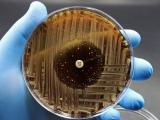Jun 3, 2010 (CIDRAP News) – Scientists say they have identified factors that helped enable antiviral-resistant seasonal H1N1 influenza viruses, which previously were regarded as evolutionary weaklings, to spread around the world starting in 2007.
Writing in Science, researchers at the California Institute of Technology report the discovery of a pair of secondary mutations that improved the "fitness" of H1N1 viruses carrying the mutation that confers oseltamivir resistance, helping to pave the way for their global dissemination. One implication is that these secondary mutations could be a predictor of the spread of oseltamivir resistance in other flu viruses, such as the pandemic H1N1 or avian H5N1.
Seasonal H1N1 viruses—one of the three flu subtypes that typically circulate in any given season—began to show resistance to oseltamivir (Tamiflu) in the 2007-08 Northern Hemisphere flu season, and in the following season the resistant strain spread around the world.
In the recently ended 2009-10 season, the seasonal H1N1 strain was pushed aside by the 2009 pandemic H1N1 virus, which in most cases remains susceptible to oseltamivir. But why the resistance spread globally has remained a mystery, because oseltamivir was not used widely enough to create strong evolutionary pressure in favor of the resistant strain.
Oseltamivir and similar antivirals target the neuraminidase (N) protein of flu viruses. After a flu virus enters a host cell and reproduces, new copies of the virus use neuraminidase to help them exit the cell. As explained in a Caltech press release about the study, new viruses leaving a cell bind to sialic acid on the cell surface, and neuraminidase cuts the sialic acid, freeing the virus to invade other cells.
Oseltamivir binds to neuraminidase, preventing it from cutting the sialic acid and setting the virus free. But the H274Y mutation slightly changes the shape of a crucial region of neuraminidase, blocking oseltamivir from attaching to it.
This resistance mutation, however, "seemed to interfere with the virus's ability to replicate and be transmitted," Jesse D. Bloom, first author of the study, said in the news release. The team hypothesized that the mutation was preventing neuraminidase from reaching the cell membrane, blocking its function of helping the virus escape the cell. The researchers confirmed this by injecting neuraminidases from resistant and nonresistant viruses into cells and assessing the neuraminidase activity at the cell surface, according to their report.
Bloom and colleagues further hypothesized that some other neuraminidase mutation or mutations must have arisen to compensate for the handicap associated with the resistance mutation. They searched for such mutations by analyzing the gene sequences of H1N1 viruses in the lineage that acquired oseltamivir resistance.
They found two such mutations, called V234M and R222Q, in drug-resistant H1N1 viruses from the 2007-08 season. In a series of experiments, they then confirmed that the two mutations restored the fitness of the H274Y viruses to the level seen in nonresistant viruses, according to the report. The authors' examination of viral gene sequences showed that the two mutations had emerged before the resistance mutation became widespread.
"The evolution of oseltamivir resistance was therefore enabled by 'permissive' mutations that allowed the virus to tolerate subsequent occurrences of H274Y," the scientists write. "An understanding of this process may provide a basis for predicting the evolution of oseltamivir resistance in other flu strains."
In a commentary accompanying the report, Edward C. Holmes of the Center for Infectious Disease Dynamics at Pennsylvania State University agrees with this suggestion, saying viral lineages that have the V234M and R222Q mutations should get special scrutiny for possible drug resistance. He adds that the pandemic H1N1 virus is the most important target for such forecasting at this point.
Holmes notes that resistance in the pandemic virus has been fairly rare so far, with only about 1% of the 2,500 pandemic H1N1 sequences in GenBank having H274Y. And neither V234M nor R222Q has been found in any of the pandemic H1N1 viruses. Holmes says the absence of these mutations may be the reason oseltamivir resistance has not become widespread in the pandemic virus.
While acknowledging that the two "permissive mutations" seemed to restore the fitness of resistant seasonal H1N1, Holmes says it is still not fully clear why the resistant viruses spread around the world, since oseltamivir does not seem to have been used widely enough to create strong pressure in that direction.
One possibility is that H274Y became linked by chance to "a major fitness-enhancing mutation" somewhere else in the viral genome, but genetic analysis of seasonal H1N1 viruses have provided no evidence for such an event so far, Holmes writes. Another possibility, he says, is that the V234M and R222Q mutations not only restored the fitness of resistant viruses, but made them even more fit than their nonresistant counterparts.
Bloom JD, Gong LI, Baltimore D. Permissive secondary mutations enable the evolution of influenza oseltamivir resistance. Science 2010 Jun 4;328(5983):1272-5 [Abstract]
Holmes EC. Helping the resistance. (Commentary) Science 2010 Jun 4;328(5983):1243-4 [Abstract]
See also:
Jun 3 Caltech press release
http://media.caltech.edu/press_releases/13352





















